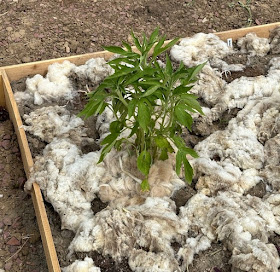 |
| Capella Ranch, Lafayette All photos by Patty Caughlin |
Last May, I had the opportunity to visit the Bee Huts at Capella Ranch in Lafayette, CO. While touring the Ranch, I saw the sight above. It looked like snow, but after talking with Carolyn, one of the owners, she told me that this was “waste wool” from sheep that was covering the new plants and seeds! My curiosity was piqued - I had never heard of wool being used for gardening mulch, so I decided to investigate.
Most of the studies on wool mulch, I found, have been done
using sheep wool. While most of the wool
obtained during shearing is used in textile production, 20% of it - the “waste wool”
from the hind area and underbelly, is discarded. During Covid, when interest in home gardening
exploded, this waste wool, an organic, biodegradable substance, found its
niche.
- Water
savings
- Fertilization
- Increased
porosity of hard clay soils
- Pest
control
Wool acts like a sponge, holding up to 20 to 30 times its weight in water. Think of wearing a wool sweater in the rain. Wool “wicks away” water from the skin. When mixed into the soil, wool holds the water closer to the plant roots, allowing a “slow release” action, helping to avoid overwatering. In turn, this aids in water conservation. Albert Wilde, a 6th generation sheep rancher from Utah who has patented the development of wool pellets as a gardening supplement, worked with university research teams, conducting a “wilt study.” This study involved planting identical plants in 4” pots, each with an equal amount of water to start, then observing how long it took the plants to die without the reintroduction of water. Here is what they found:
- Traditional
soil had wilting plants on days 1 and 2 and dead plants on days 5 and 6
- Soil married
with wool had wilting plants on days 7 and 8 and then dead plants on day
14
Wool is also an excellent fertilizer. Wool is high in Nitrogen (9.3-14% compared to compost which contains 1-2%) and it biodegrades slowly, typically over 1 – 2 years. Wilde, in conjunction with Utah State University Extension researchers, found that greenhouse-grown tomatoes could be market-ready in half the time if wool pellets were added to the soil (76 days (about 2 and a half months) to 38 days). They liked the nitrogen pop!
Because of its ability to absorb so much water, wool can also aid in breaking apart impacted clay soils, thus increasing the passage of oxygen and nutrients to the plant roots.
Finally, observational studies have shown some benefits in pest control. The shaft of the sheep wool fiber contains barbs. Think about how wool is “scratchy” on the skin. This is due to the barbs on the wool fibers. Slugs and aphids may be deterred by the barbs, though I could not find any research studies to verify this. There have been some reports of the deer being repelled by the smell of the wool.
Waste wool can be purchased from local ranchers, and wool pellets can be purchased online from several sources. I just googled “waste wool” and multiple sites popped up.
 |
| "After" showing plants growing with wool mulch |
“4 Reasons to introduce wool into your garden”, American
Wool, May 21, 2021.
“Wool: A Natural Bio-Enhancement for Gardens”, Jaelyn
Whaley, South Dakota State University Extension, June 6, 2024.
“The Use of Wool in Compost and other
Alternative Applications”, Ohio State University Sheep Team, Dr. Cate
Williams, March 23, 2021.
https://u.osu.edu/sheep/2021/03/23/the-use-of-wool-in-compost-and-other-alternative-applications/
Special thanks to Carolyn Peterson, owner of Capella Ranch for allowing me to visit the Ranch and take pictures!
